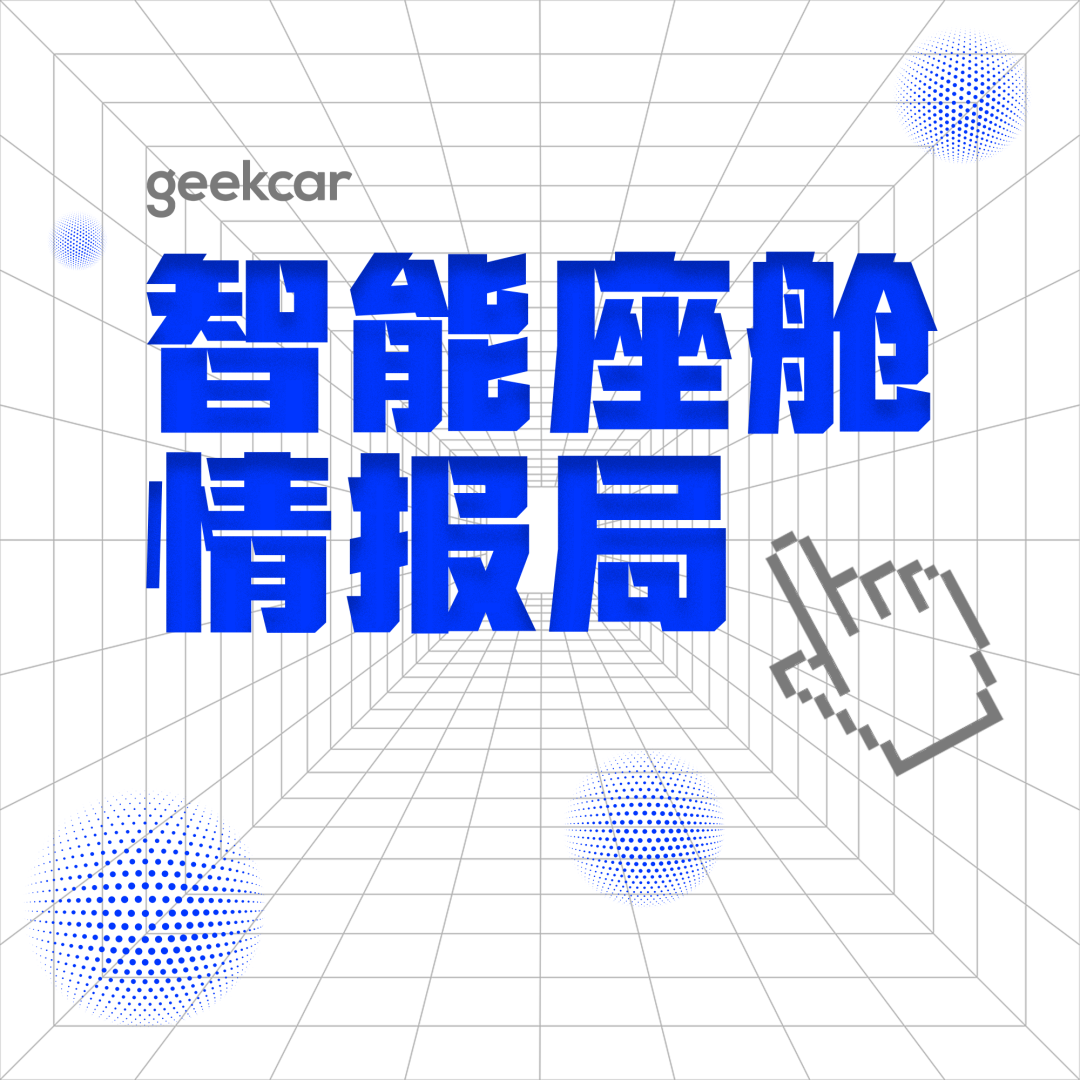Hello everyone, here is the second episode of the third season of GeekCar’s Intelligent Cockpit Intelligence Bureau, and I am Mr. Yu.
After opening a new series with the cockpit evaluation of the XPeng P7 last month, we have received a lot of attention: many industry colleagues have joined our intelligent cockpit communication community to exchange insights or connect resources; in addition, there are also business opportunities from old friends.
On the other hand, our partners in establishing the evaluation system for intelligent cockpits in this season, China Automotive Innovation Corporation (CAIC), have optimized and integrated the system with data and put it into the landing of intelligent cockpit business.
For GeekCar, to create opportunities for industry insiders and outsiders to exchange ideas in our own way, and to make a contribution to the positive development of the industry, it is of great significance.
Now let’s get back to business.
In this issue of the Intelligent Cockpit Intelligence Bureau, we will still focus on presenting various experiences, details, and analysis in the intelligent cockpit. At the end of the evaluation, we will also chat with expert VIPs about the insights and inspirations that the cockpit brings us.
Mr. Yu has always believed that chatting ten thousand times is better than reading ten thousand books. Here, we welcome everyone to come and chat with us.
As the second episode of this season, we have a familiar old friend, the Ideal ONE. To be precise, it is the 2021 model of the Ideal ONE with the on-board AI “Ideal Classmate”.
The Ideal ONE has also appeared in our previous “Wonderful Car Machine Intelligence Bureau” column. All along, whether it’s the comments under the public account content or the friends in the GeekCar intelligent cockpit communication group, they occasionally urge us to evaluate the intelligent cockpit of the Ideal ONE.
Ideal CEO Li Xiang once said at a public event, “We have statistics that Ideal ONE owners spend an average of 4.4 hours in the car without driving every week.”
What are the Ideal ONE owners doing during their 4.4 hours in the cockpit? What reasons make them stay in the cockpit?
Although Ideal ONE’s reputation as a “daddy car” is well known, the first impression is not helpful to the text you see now. Therefore, we took this opportunity of cockpit evaluation to explore the answers.
- This evaluation is based on OTA 2.2 official version of Ideal ONE, which started to be pushed in batches on September 11, 2021.### Interactive Hardware
There are four screens in the intelligent cabin of the Ideal ONE, forming an almost horizontal “T” shaped screen matrix that spans the entire front row. Most interactive features that require physical contact occur in several areas.
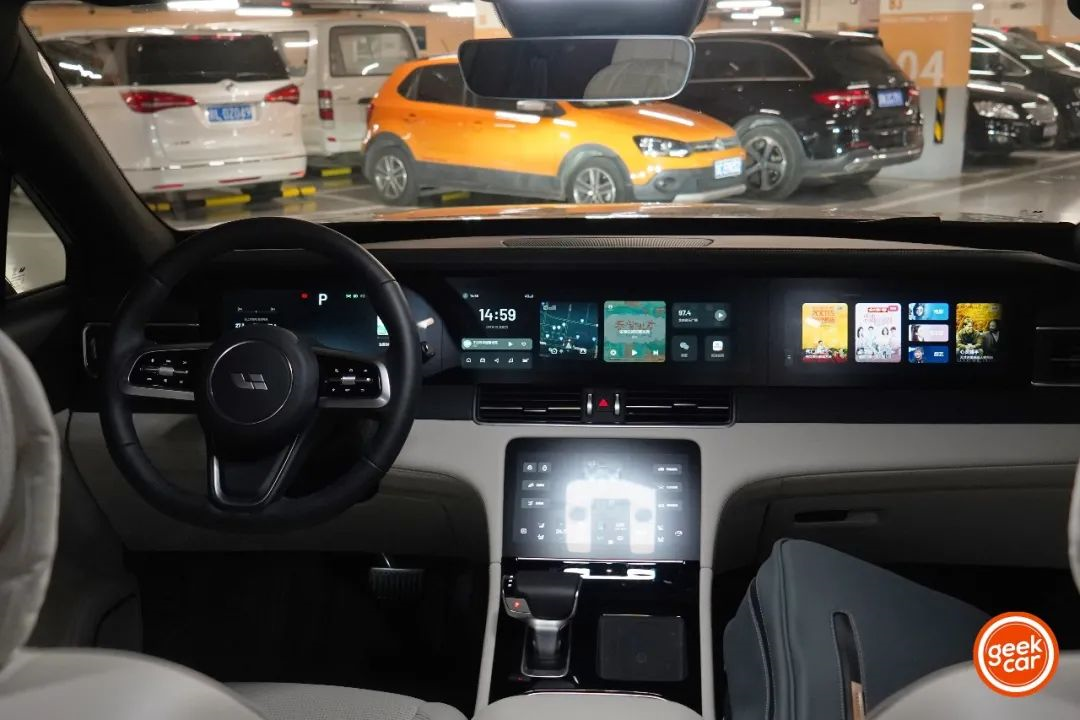
From left to right, they are: instrument panel, central control screen, co-pilot entertainment screen, and vehicle function control screen located below.
The 12.3-inch instrument panel on the left and the 10.1-inch vehicle function control screen below are driven by Texas Instruments J6 chips, with resolutions of 1920×720 and 1280×720, respectively, running a relatively stable Linux system.
The 16.2-inch central control screen in the middle and the 12.3-inch co-pilot entertainment screen on the right are driven by Qualcomm Snapdragon 820A, with resolutions of 2608×720 and 1920×720, respectively, and run the Android system, which is loved by many new domestic automakers.
Touch Screen Control
What is unique is that physical buttons are rarely seen in the Ideal ONE cabin, except in the steering wheel control area.
This bold design must have its reasons, which the Ideal team of engineers undoubtedly has.
As we mentioned earlier, except in the steering wheel area, there are very few physical buttons in the Ideal ONE cabin, and corresponding to them, the central control screen and co-pilot entertainment screen support a series of blind-operation gestures:
- Swipe up / down in the center area of the vehicle control screen to adjust the air conditioning temperature;
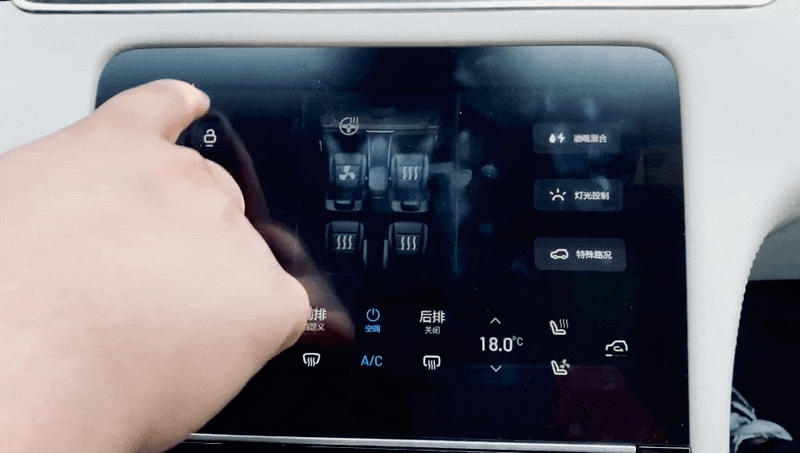
-
Swipe left / right on the vehicle control screen to adjust the air conditioning airflow size;
-
Any three-finger swipe in any direction on the central control screen / co-pilot entertainment screen will return to the home page.
In addition to the third return operation, the first two air conditioning adjustment actions will display corresponding values on the instrument panel:
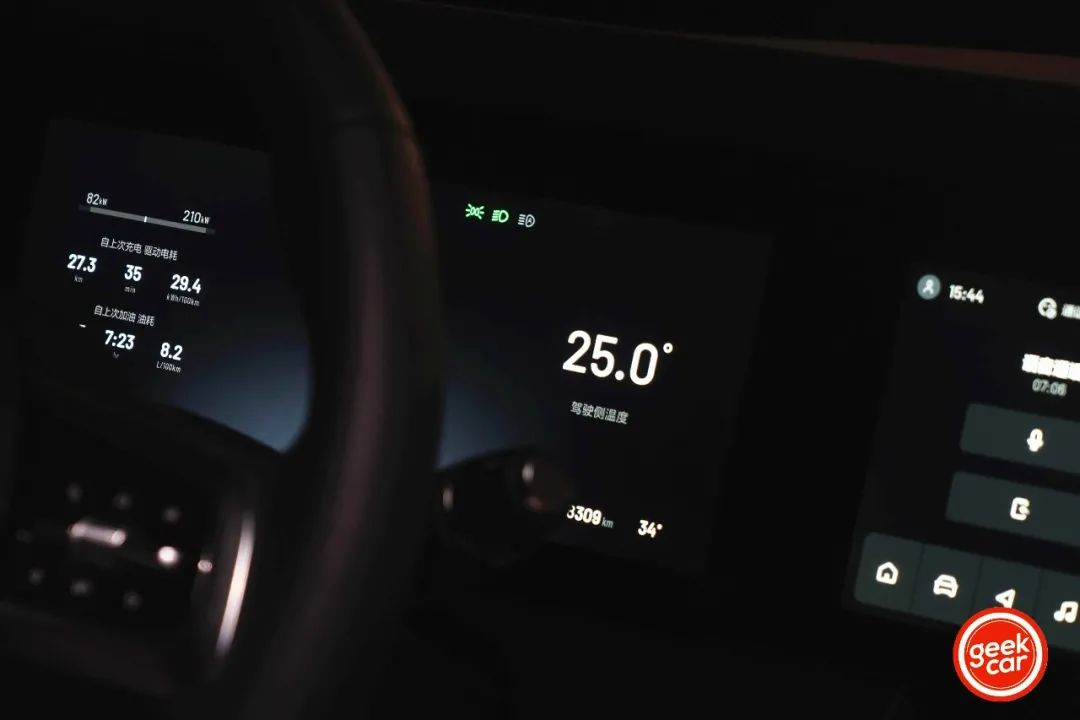
Visual Elements
The Ideal ONE’s system interface is mainly cool-toned, displaying mainly black, white, and gray, with light blue used to indicate function and switch statuses. As we can see, under this system, the color styles of each level are relatively consistent.
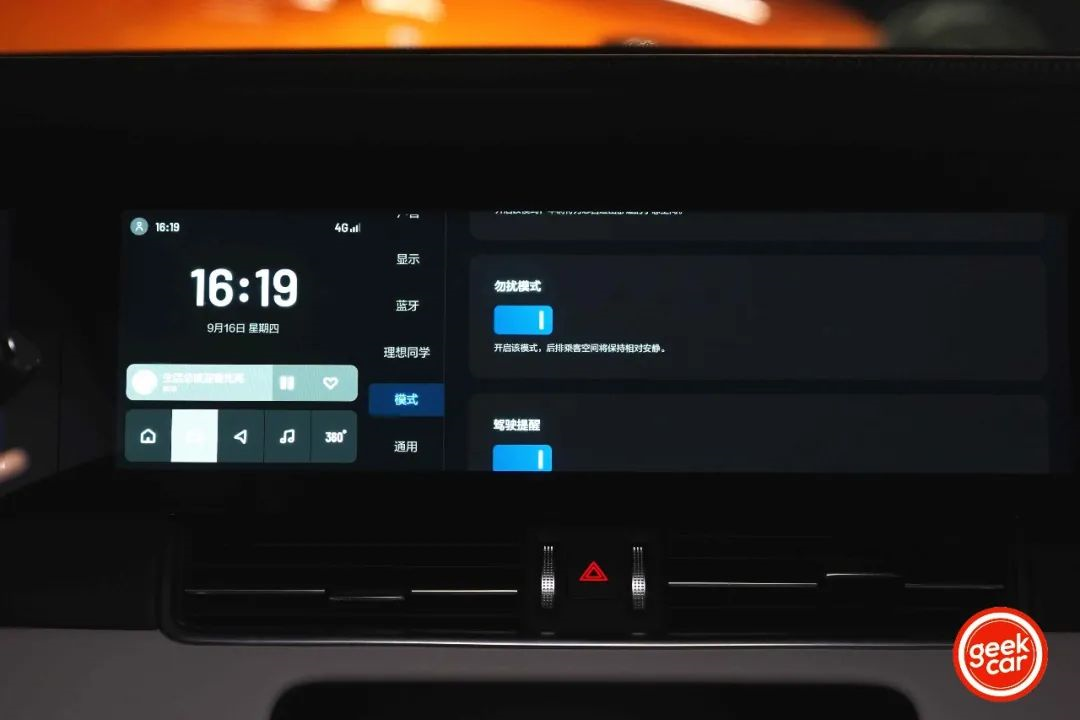 However, the ideal ONE system does not have a light mode. The GeekCar and CAIC partners believe that there is likely some thought from the ideal team behind this decision.
However, the ideal ONE system does not have a light mode. The GeekCar and CAIC partners believe that there is likely some thought from the ideal team behind this decision.
To verify our hypothesis, Mr. Yu referred to several interior colors on the ideal website’s vehicle customization page. The results showed that except for the vehicle control screen located under the T-shaped instrument panel, the borders and surroundings of the glass panel of the instrument panel, central control screen, and co-pilot entertainment screen were black and remained dark. This may be because the ideal design team wanted to enhance the screen immersion while avoiding a visually inconsistent overall interface caused by a primarily light-colored system, which would reduce visual comfort.
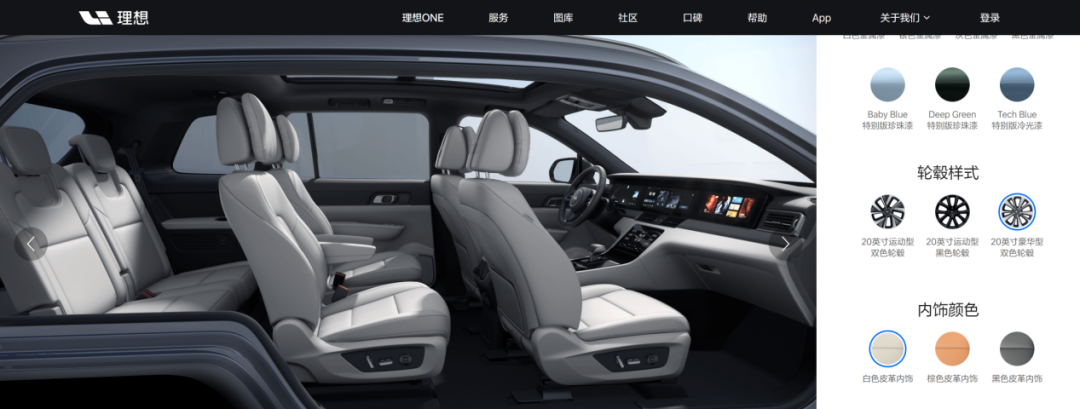
Smoothness
As mentioned earlier, the ideal ONE’s four screens use two chips and two systems.
The Linux system on the instrument panel and vehicle control screen exhibits relatively good handling smoothness. This is consistent with its positioning, which aims to reduce attention expenditure as much as possible during operation.
The overall smoothness of the Android system on the central control screen and co-pilot entertainment screen is slightly inferior to that of the previous two screens, but still within a reasonable range. In addition, the overall system interface’s “left-to-right” presentation is relatively reasonable and does not result in significant lag or discomfort during actual use.
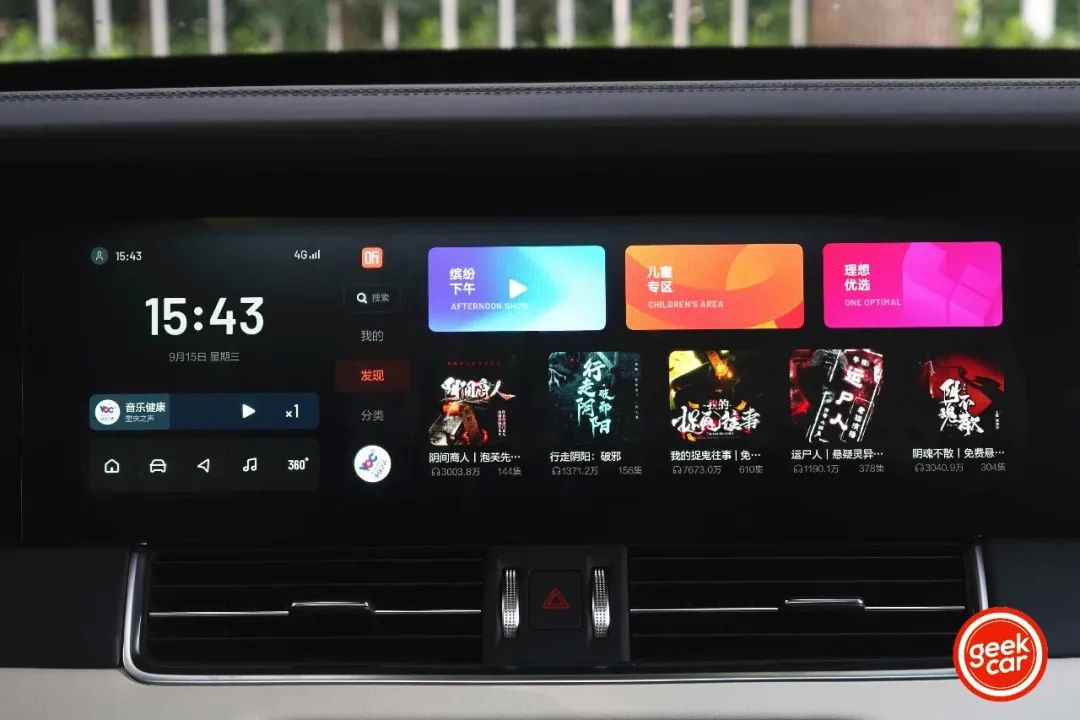

An Attempt to Connect Work and Life
The ideal ONE has two main map resources, namely, Gaode Map and Tencent Map.
After comparison, the in-car version of Gaode Map exhibits high integration and adaptability with the cockpit system, including some quick operations. Thus, the current evaluation mainly focuses on the use of Gaode Map.
The in-car version of Gaode Map on ideal ONE also supports Location-Based Services (LBS), which can recommend places based on the current location for parking, refueling, charging, consumption, travel, and other scenarios.
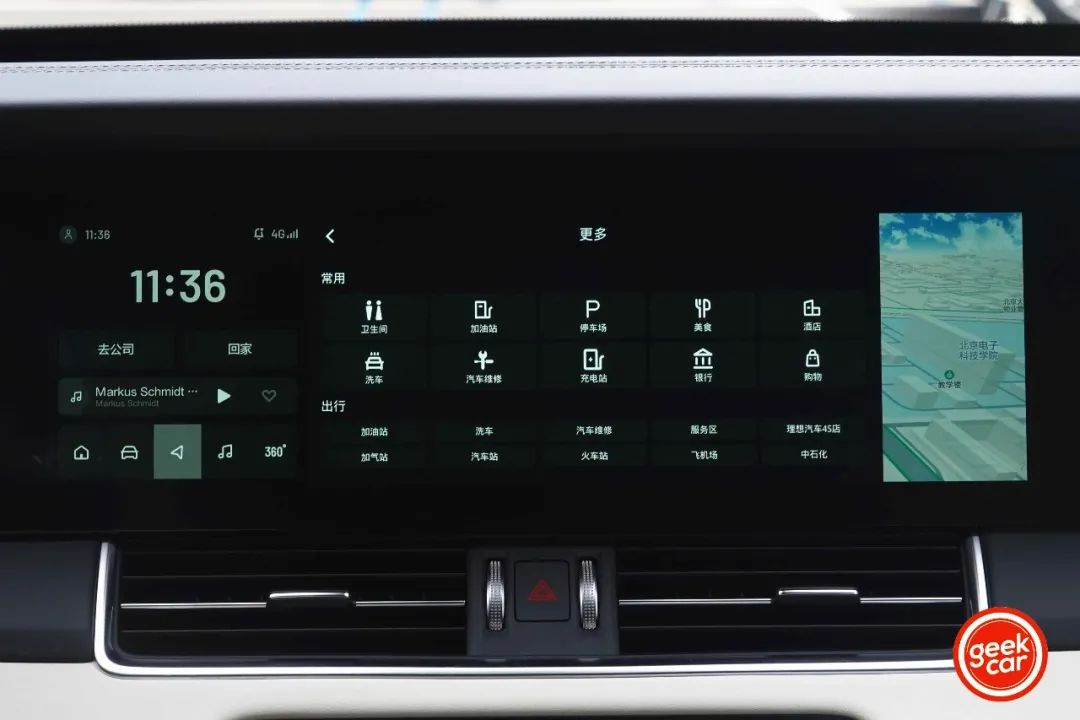
At the same time, the navigation card on the central control screen also has quick buttons. Under normal circumstances, the buttons correspond to the “home” and “company” locations set by the user in the navigation, enabling one-click navigation to these locations.In addition, it has been noted that if the Gaode Map enters the navigation mode, the shortcut buttons on the navigation card will change to “refueling”, “charging” and “catering”; when exiting the navigation, they will return to the usual state of “one-click return home / go to company”. The logic of this design is not clear, and Mr. Yu speculates that it may be due to the consideration of temporary needs such as refueling and charging during the design.
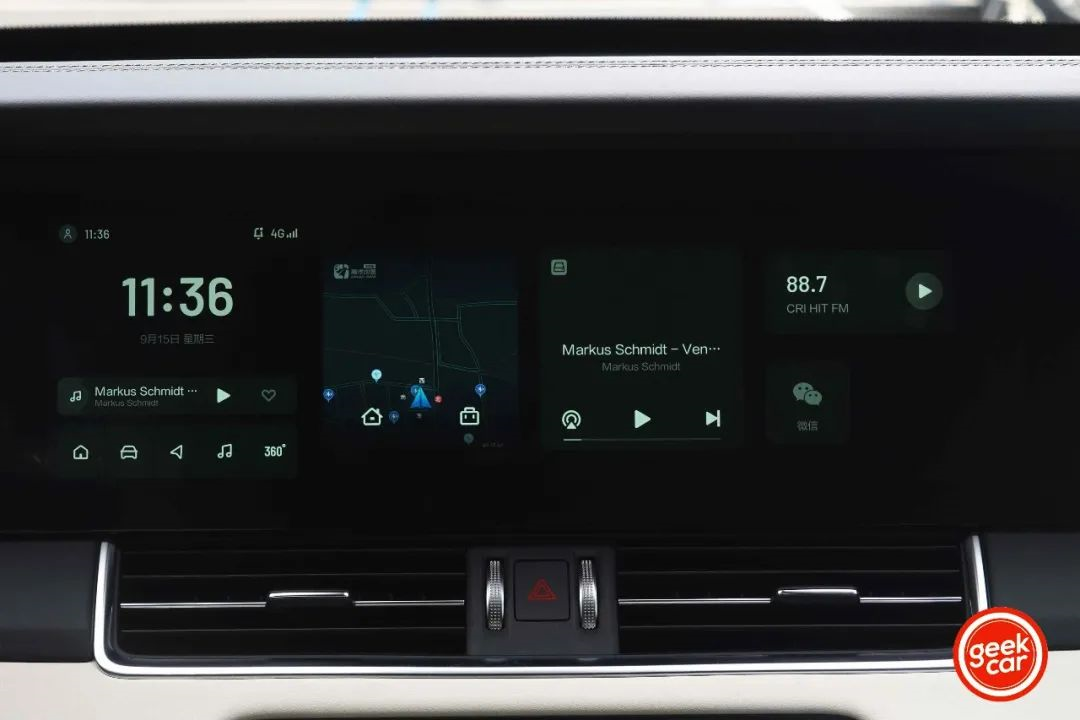
In our intelligent cockpit evaluation system, there is a design consideration for the ability of the vehicle to perform inertial navigation when GPS signals are weak. After testing in scenarios such as suburban tunnels, the combination of Li Xiang ONE and Gaode Map performed relatively well in terms of inertial navigation. While driving in the tunnel, there was no stuttering displacement of the navigation position, and when the vehicle resumed its positioning signal upon exiting the tunnel, the displayed vehicle position was relatively accurate, and the navigation did not show the situation of the vehicle icon “teleporting” on the map.
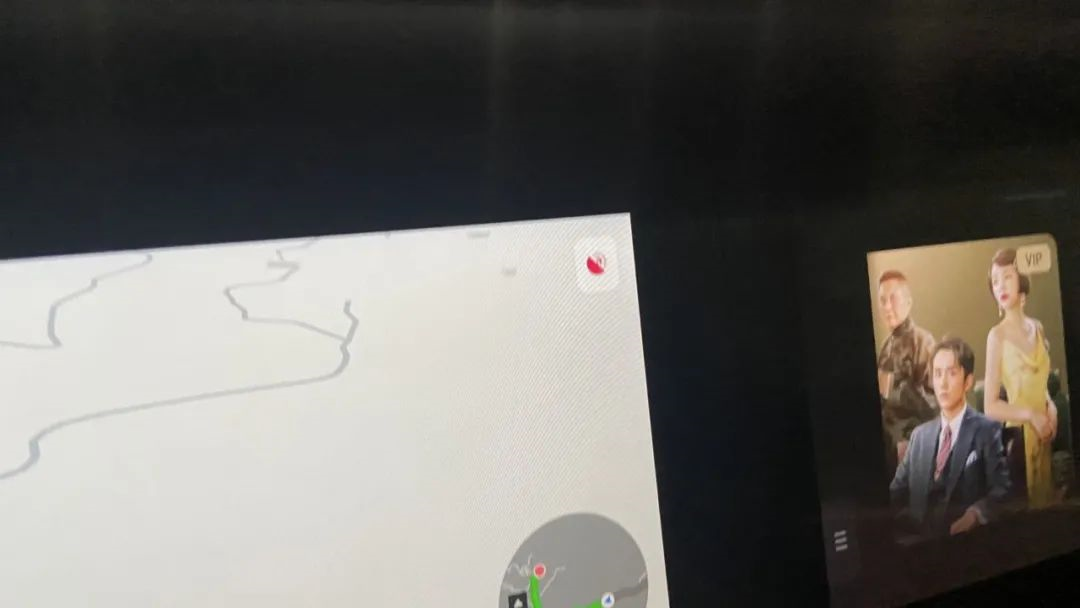
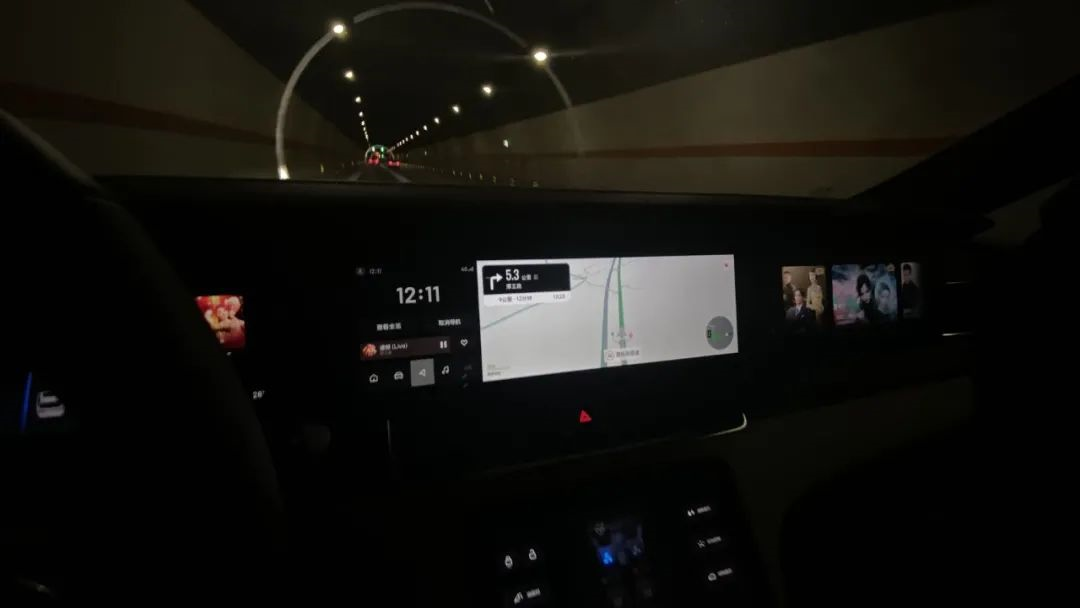
In addition, the on-board version of Gaode Map on Li Xiang ONE has been deeply connected with the mobile end. After the user logs in to their personal settings, the relevant settings and search records on the mobile end will be synced to the vehicle end, avoiding the need to “rediscover” everything. At the same time, just like most on-board navigation systems, any changes made in the vehicle’s settings cannot be synchronized back to the mobile end, which may cause inconvenience, depending on the user’s personal usage habits.
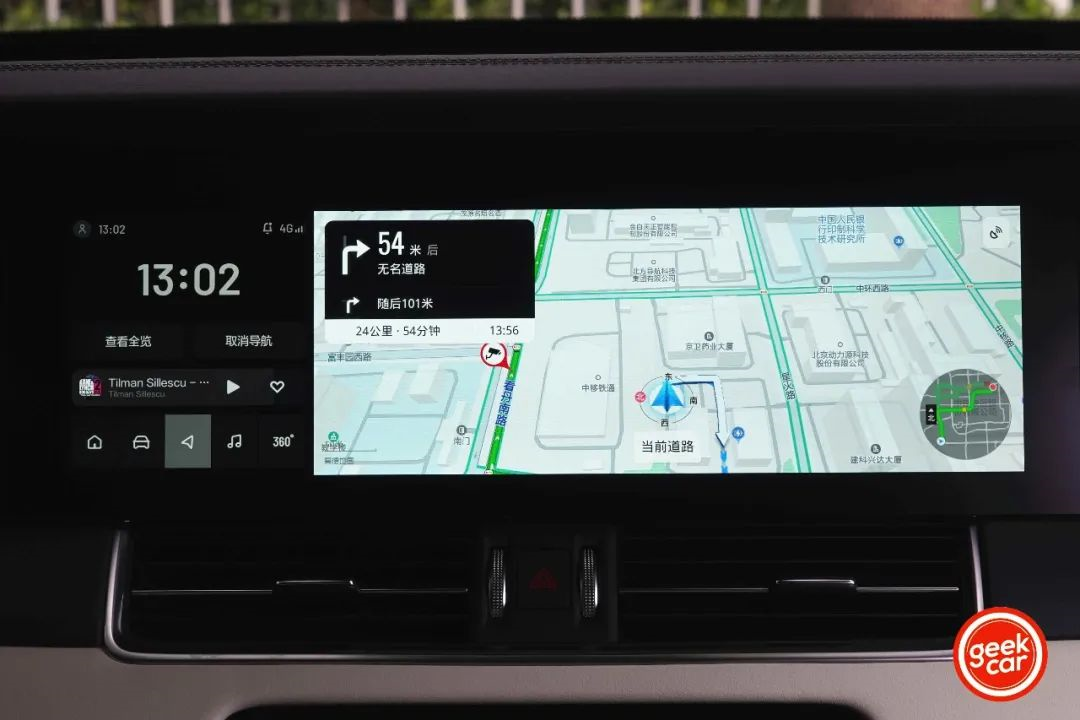
By the way, in Li Xiang Auto’s 2021 update plan roadmap released earlier this year, there are plans to bring in applications such as Baidu Maps and Kara OK. Now that two-thirds of 2021 have passed, Kara OK has already appeared on the co-pilot entertainment screen. It remains to be seen whether Li Xiang can summon the dragon by adding “BAT” navigation apps (Gaode Maps is a brand under Alibaba) by the end of this year.
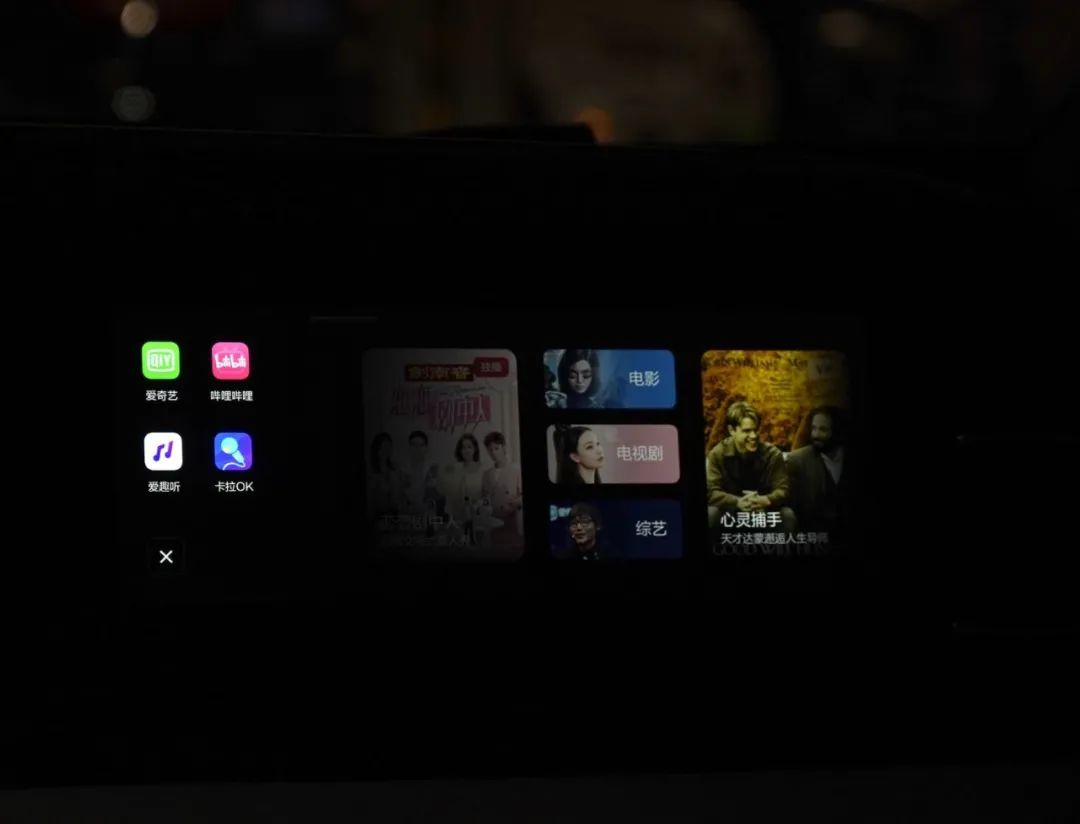
Li Xiang ONE’s Gaode Map features multiple downloadable voice packages, with tones ranging from Lin Zhiling’s to the queen of De Yun’s cross-talk, Yu Qian. If Baidu Maps successfully joins the ecosystem, it is strongly requested for the representative Guo Degang voice package to be included as well.Although Mr. Yu was just watching the excitement, in reality, allowing users to configure familiar navigation applications based on their own habits in the same cabin is a kind of freedom of choice.
At that time, “One Car Three Screens” may be difficult to distinguish, but the winner will definitely be Li Xiang Company.

One week before driving this gray 2021 Ideal ONE, Mr. Yu and a group of media colleagues were invited to attend a small-scale media communication meeting held by Li Xiang on September 7th. During the meeting, Hu Han, the product manager of Ideal Voice Team, explained the upcoming updated content, and the vehicle carrying the OTA 2.2 beta version was also opened for everyone to experience and obtain material.
Like the beta version, the official version OTA 2.2 update mainly reflects the in-car AI “Ideal Classmate”‘s speech interaction ability and application ecology.
It’s a bit unfortunate that we still haven’t seen IoT-related functions such as car-home interconnection in the updated Ideal ONE cabin.
Quality Over Quantity in Applications
After the OTA 2.2 update, including the newly added Sina News, Netease Cloud Music, and Lizhi Podcast, the total number of applications in the Ideal App Store has increased to nine.
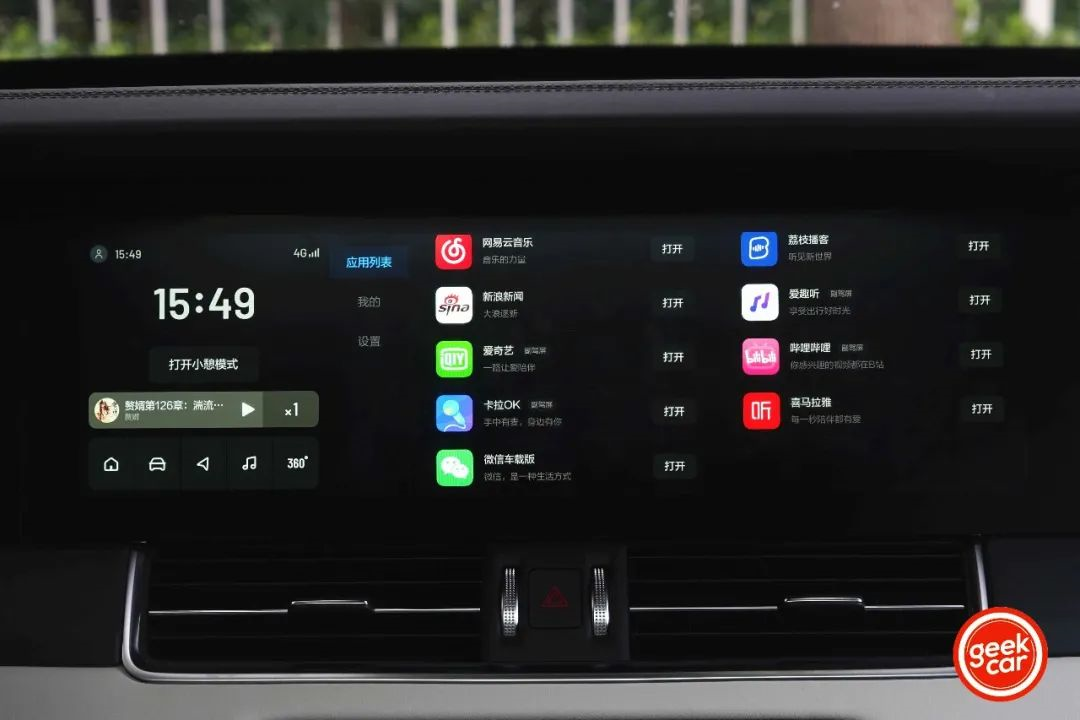
Let’s take a look at the three new applications in this update.
NetEase Cloud Music: There is not much to say about the platform itself. The move of integrating “WangyiCloud” is a complement of Ideal ONE to the matrix of commonly used platforms and copyright. It is worth appreciating. In Mr. Yu’s opinion, copyright music is only a part of it. At present, the community culture, UGC, and PGC content, and other characteristics of “Cloud Village” derived from the platform cannot be realized on the in-car end due to various considerations such as the limitation of the scene and driving safety- at least before the product team finds a more reasonable landing method.
Lizhi Podcast: After Lizhi FM decided to break through the traditional arts network podcast market through network broadcasting, traditional network podcasts seem to be less popular than before. Coupled with the strong content of its rival Himalaya, the continuous integration of netease cloud music on the platform, and newcomers such as “Little Universe” that combines the feelings and ambitions of playing podcasts, Lizhi FM simply turned network podcasts into a new platform to focus on differentiated operations. To introduce it into the cabin of Ideal ONE, it is undoubtedly the best choice among podcast platform applications for now.
Sina News: This is a graphics and text news platform. There is also not much to say about it. It can be regarded as the team’s complement of application types in-car.Remember when XPeng P7’s Xmart OS added hardware-intensive games like “Genshin Impact” and “Honkai Impact 3” to the car? Meanwhile, the Ideal One team seemed too restrained in their selection of applications.
As the earliest platform to “hop on board” Bilibili, although the co-pilot entertainment screen of the Ideal One may occasionally drop frames when playing 1080P high-bitrate videos on Bilibili, it still manages to maintain a minimum level of smoothness.
Compared to Tesla’s bold move of directly adding the Bilibili webpage as a vehicle application, the Ideal One’s limited number of applications clearly underwent careful polishing:
- The user interface now uniformly extends from left to right and adheres to the ideal design language, fitting in with the widescreen operating habits. In addition, the black vinyl record of Netease Cloud Music has been integrated.
- Furthermore, new applications also support Ideal students’ comprehensive voice control. For instance, “what you see, you can say.”
Based on observations, Ideal’s team seems to prioritize adding applications with the highest user demand.
As our reviews delve deeper, it becomes apparent that these observations are only part of the story.
In terms of voice control, Ideal One’s on-board intelligent voice assistant “Ideal Fellow” performs well in car navigation, content playback, cabin control, and vehicle control. It supports frequently-used features like media playback control and map zooming through wake-free operations. Not only does this simplify daily routines, but it also elevates the overall experience.
In terms of visible voice control, Ideal One supports the most interactive operation frequency of media playback, while air conditioning and navigation interfaces are not supported. In offline network conditions, Ideal Fellow exhibits remarkably stable control capabilities for both the vehicle and cabin functions, ensuring precise and swift controls even without network support.
According to Ideal, its team specifically developed an edge-computing-based engine for speech recognition and semantic understanding. In the absence of external network connections, the in-car AI prioritizes speech recognition rates and adjusts to be more biased toward the current page’s content, ensuring a stable interactive experience for users. This suggests that the dual-end fusion solution for speech capabilities is becoming the mainstream for in-car AI voice.
Finally, let’s touch on some related thoughts.## Three OTA Updates for Intelligent Driving Assistants from NIO, Xpeng, and Tesla
Just a month ago, Xpeng released OTA update Xmart OS 2.6.1, while NIO unveiled the new version, NIO OS 3.0, on August 31 at its user communication meeting, all with major enhancements to their in-car AI voice assistants. Whether or not there was collusion between these players remains unclear, but at least it indicates the recognition in the industry of the critical importance of voice command to automotive products, particularly to the new neoteric players who have been fast in leveraging their advantage in connectivity to speed up the practical applications.
Voice Wake-up Performance in Different Scenarios
Using a new testing methodology, we evaluated the intelligence voice assistant’s voice wake-up and recognition accuracy under static and dynamic ambient noise environments, specifically when the car window is completely closed, in situations with high wind noise, and with the air conditioning at the maximum level.
Surprisingly, while the success rate for waking up the voice assistant in still conditions was only 50%, and dropped to 40% with the window open, it jumped to 100% when the air conditioning was at its highest level with in-vehicle noise. The same phenomenon continued with broadcasting, music playing, and even chatting, such that the noisier the situation, the higher the rate of recognizing voice commands, up to 100%.
In high-speed driving scenarios, where the wind noise was generated by car windows being rolled down to one-third open, the success rate was 90%, but dropped to 70% when the windows were closed, and rose to 80% when the air conditioning was turned up to the maximum level.
We concluded that the intelligent voice assistant must have done sufficient noise reduction and clarity enhancement for voice command processing to ensure a higher success rate. However, it’s still confusing that the assistant is harder to wake up in a quieter environment. We hope this is just an isolated case in our evaluation work.
Practicality over Showmanship in Voice Interaction
In addition, successful voice interaction should be more practical than offering fancy skills.According to Hu Han, the product manager of Ideal Auto’s speech product team, one of the main directions of OTA 2.2 landing is to solve the pain point of “inconvenience” when speaking in the car.
Visible and Speakable — Beyond the ability of speech itself, Visible and Speakable also plays an auxiliary guiding role. For new users of intelligent speech products, the frequency of interaction in the initial contact is usually the highest. Ideal’s expectation of “ideal students” is to provide interactive value and deepen users’ trust in the product unconsciously as they gradually become familiar with it together with the expectation value.
Multi-tone zone Dialogue Locking & Contextual Understanding — In most cases, people only discuss whether the recognition area in the car is a dual-tone zone or a four-tone zone. In OTA 2.2, the locking command initiator was added, and the reception and execution of interactive instructions would not be interfered with by other passengers’ conversations in the car. According to actual testing, during the 20-second waking interaction process, Ideal’s AI did receive a lot of irrelevant information displayed on the screen, but the real instructions were accurately recognized and implemented. The main driver can also choose to turn off the wake-up sound zone except for themselves separately to ensure unified control of the overall cabin operation status.
Ideal’s speech product team has also added cross-tone zone contextual dialogues, enabling rear passengers to achieve the same effect by saying “Ideal, I want to adjust the air temperature” after the main driver initiates the instruction to adjust the air temperature.
We believe that the intelligent cabin of Ideal ONE is currently moving towards the expected direction, regardless of where Ideal AI is in its development. The positioning of Ideal ONE as a car model for family users and the brand’s expectations for Ideal AI’s positioning have not deviated from the word “home” — a moving home, a happy home, a steward, a family member.
Regardless of how far Ideal AI has come, its positioning cannot be just “loyal” to a single user like AI on personal smartphones or wearable devices. As a vehicle-mounted AI facing family users, Ideal ONE’s AI needs to frequently face the famous AI speech problem of “cocktail party effect” — you may be able to distinguish who is communicating with you in a noisy cocktail party, but it is challenging for AI that cannot rely on human common sense to understand and judge.
Image: The brand-new Ideal ONE Intelligent Cabin.
Different from the IP operation company that invests heavily in building virtual idols for subcultures, the current “butler” role in the cabin cannot become a family member. Even if it is very useful, it can only be a tool. At the fundamental level, the two are not necessarily progressive. Through the analysis of speech performance and product, we believe that an ideal team is trying to continuously improve the “IQ” and “EQ” of the ideal classmate as an auxiliary AI through iterative iteration to enhance users’ trust, while exploring and deepening the “bonding” between humans and machines through daily communication.
Here we want to use a more romantic “binding feeling” to replace the cold “user stickiness”.
This requires the ideal classmate to be able to serve as a high IQ “butler” while also having enough “EQ” to become a “family member” that users can project emotions onto. This poses a considerable challenge to product planning beyond interaction capability.
Be a person first, and then talk about emotions
The prerequisite for emotional projection is to be “like a person”. Even if your phone is very useful, you won’t fall in love with it, will you?
From the performance after OTA 2.2 update, the answer given by the ideal team is to give the ideal classmate a speech performance that is close to that of a real person. In the relevant articles on Ideal Automotive WeChat public account, it is described as “Ideal Automotive and Microsoft jointly launched a cloud-based speech synthesis model based on deep neural networks, with human-like sentiment”.
We are not here to discuss the official update instructions, so Mr. Yu decided to use storytelling to conduct analysis in a different way.
At the Ideal Automotive media communication meeting on September 7th, a video of the ideal classmate reciting Zhuge Liang’s “Chu Shi Biao” was played on the spot: “The late emperor started his work but unfortunately passed away. Now the country is divided into three parts, and Yizhou is weak and exhausted. This is truly a time of crisis for survival…”.
For those whose DNA is stirring, please sit down. This is not a Chinese class in middle school, and we do not require full recitation of the text.
From the on-site performance, although it is not as touching and emotional as Teacher Tang Guoqiang’s interpretation of Prime Minister Zhuge’s joys and sorrows, the natural, smooth, and rhythmic performance of the ideal classmate is already very close to the performance of a professional human voice actor.
It must be said that there is a certain level of technical prowess in this arrangement. But when Microsoft, AI voice, and ancient poetry recitation elements appear together, it happens to be associated with a product called “Microsoft Xiaoxiao”, which Mr. Yu knows about, under Microsoft’s intelligent speech synthesis (Text-To-Speech, TTS) technology.At the media communication meeting, it was confirmed through verification with Hu Han that the improvement in Ideal students’ speech expressiveness and emotional richness was indeed achieved through collaboration between Microsoft Asia Internet Engineering Institute’s AI voice team and Ideal Voice Product Team.
We will not go into the details of Microsoft Xiaoxiao’s TTS capabilities here. It suffices to understand that previously, related technologies were typically used in the form of audio content creation platforms for visually impaired people as public welfare-oriented audio content production.
In addition, we can reveal a small detail. In Mr. Yu’s past work participation, Microsoft Xiaoxiao has been able to simulate multiple dialects and recreate the shouting and exchanging of goods in the streets with high fidelity. Based on Mr. Yu’s understanding of Beijing’s traditional language and culture, with trained samples of high quality, Microsoft Xiaoxiao’s speech demo after a short-term adjustment can achieve a similarity of 70% to 80% with folk artists’ performances.
Similarly, in a recent media interview, it was mentioned that XPeng’s in-car AI “Xiao P” had significantly improved its speech expressiveness through OTA updates, which was also related to the same team at the Microsoft Asia Internet Engineering Institute.
From this we can see that new car-making forces have already crossed the initial stage of “function + intelligence” in the cockpit, by attempting to establish a deeper emotional connection with users through highly personalized intelligent voice interaction.
According to reports, the upgraded Ideal student achieved a score of 4.49 in the international standard speech quality evaluation method MOS, which is the closest to the maximum score of 5 points achieved by any intelligent voice except for humans.
This sentence is copied from the conclusion section of the previous issue, but it is not lazy, as we have obtained the same numerical value from Ideal’s public information.
On the application ecosystem level, the Ideal team has exhibited a tendency towards quality over quantity, by integrating third-party applications and cabin systems more deeply through continuous refinement, in order to maintain a unified user experience.
We believe that the overall performance of the Ideal ONE cabin in terms of application availability and voice-related experience is excellent.
If Ideal’s team can solve the related problems mentioned later through continuous development and optimization, we believe they can receive higher praise in the future.
Here, we will discuss some points worth discussing from each evaluation.
The purpose of setting this section is not to dictate or criticize the product or team’s work. We hope that these words can serve as a stimulus for independent thinking.
Interaction Level## 1. Frequent Miswaking
At this moment, the wake-up words we are familiar with and used to in various cabins are mostly three to four syllables, such as “Hey, NOMI” or “Hello, Xiao P”, which at least contains one or two greeting words. However, the ideal companion in the Ideal ONE cabin does not require any interjection in terms of syntax. Just saying “Ideal Companion” is enough.
As a result, there is a funny and annoying phenomenon: whether it is evaluation work or car conversation, especially on the topic of cabins, as long as the name of the ideal companion appears, it will pop up at the first time no matter whether it is relevant or not.
Undoubtedly, this name gives the Ideal ONE intelligent cabin itself a friendly and trustworthy title. However, whether this way of interaction initiation accompanied by frequent miswaking is the optimal solution, it is obviously still up to the product team to consider.
Moreover, every time we talk about “it”, we are more willing to use the full name to refer to it, which itself has indicated that we subconsciously accept the fact that ideal companion is personified as a cabin personality.
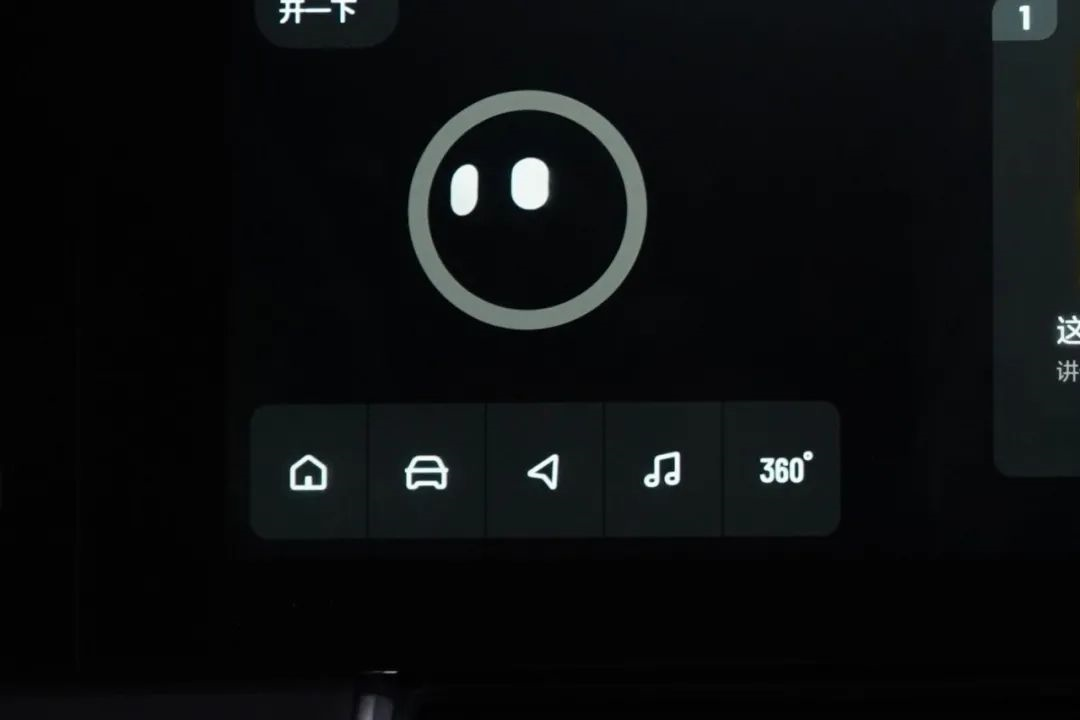
2. Mysterious Wake-up Success Rate
This point is better combined with the previous one.
How to wake up the Ideal Companion by voice has become the biggest problem we are facing in the Ideal ONE evaluation work these days, and there is no other issue that is larger than this.
It is unclear whether it is because the Beijing accent is too obvious, or Mr. Yu’s pronunciation happens to be not within the range that the Ideal Companion can recognize well, the wake-up rate is not high.
After testing, trying to softly call out, read word by word, use broadcast voice, use beautiful voice, or even mentioning the name during the chat, the wake-up success rate of the Ideal Companion is higher than the volume and tone that we are most used to in daily life.
At this stage, Ideal ONE does not support custom wake-up words, which means that “Ideal Companion” is the only choice currently available.
3. Unable to Chat Properly, Better Not Chat
Idle chatting is one of the best ways to test the ability of continuous dialogue, contextual understanding, cross-domain, etc., and the performance of the Ideal Companion in chatting is completely different from that in voice commands. Here are two specific examples:
① Asking for the common name of a Sichuan cuisine and its recipe, the Ideal Companion will play the TTS of the search results. However, the content will stop playing mid-sentence, and the screen display will show that the voice interaction has exited. I don’t know whether it is due to the limit of the number of words or the system judges that the voice interaction has ended after a long time without input. I hope everyone, including the Ideal Voice team, can see this and take it seriously. At least it cannot be like when all the main and auxiliary ingredients have been prepared and you are just seasoning with a spoon, the recipe runs away by itself.## English Markdown
Based on these two phenomena, we believe that the speech chat function of the Ideal One is at least partly still in the framework stage and has not yet formed a complete experience.


Overall, the Ideal One’s smart cockpit experience does not have very significant shortcomings, and its comprehensive ability is undoubtedly among the top tier in terms of matching a diverse range of spatial experiences.
In terms of functionality, Ideal One performs well in terms of feature completeness, with a wide range of features, and good fine detail experiences in commonly used functions. For example, the dual map source mode of Gaode Maps and Tencent Maps attempts to meet the needs of users who prefer a certain type of map. Furthermore, the system utilizes WeChat and Gaode Maps to implement map navigation sharing and team formation, which saves energy and produces good results.
As with many other cars, in terms of ecology, Ideal One only has audio/video ecology for now, with certain categories of life service ecology missing. However, Ideal One has put a lot of effort into audio/video entertainment ecology and has a deeply customized UI/UE for the onboarding experience.
In terms of content, Ideal One has cooperated with Ximalaya FM to customize VIP content for car owners, so that best-selling content that would otherwise require payment on other platforms can be listened to for free in the Ideal One system. Additionally, bilibili is one of the most important content creation and access platforms among young people today, and Ideal One is the first to bring it into cars in order to increase the cabin’s stickiness to users.
Another key focus is on speech capability. In this 2.2 version update, Ideal One has made significant upgrades in this area. We have evaluated that speech capability cannot simply be summarized as “good” or “bad”. The “good” aspect is that the speech capability is quite comprehensive, with multi-round dialogue, interruptibility, context understanding, and wake-free capabilities. At the same time, some functions have been more deeply designed for the sake of a better experience. For example, based on the capability to recognize multiple phonetic zones, a single phonetic zone blocking feature was added to prevent excessive communication among passengers from affecting the speech experience. This is also in line with the role of the vehicle for families with children.
However, at the same time, we found that many of the higher level speech capabilities were poorly implemented, with evidence of a rushed job.
For example, the “seen, say” feature has only implemented a small portion of the interactive controls for music playback, the wake-free command function only supports song playback and map zooming in and out (with no support for functions such as adding to favorites, lyrics, and pausing), and AI idle talk only supports single-round communication and shows evidence of being a half-finished product.In terms of space, we want to highlight the practical scenarios that the IDEAL ONE has put a lot of effort into despite the limited hardware conditions in the cabin, such as rest mode, do not disturb mode, departure reminder, car cleaning, and singing mode. With the addition of the copilot screen and high power output that cater to the positioning of a “dad’s car,” the excellent ecological customization collaborates to achieve an data point, which is the average non-driving time of the IDEAL ONE owner per week being 4.4 hours, making it possible to create the “third space” that the industry has been dreaming of.
In terms of interaction, the system and ecological interaction framework maintain a consistently high level of cohesion. Furthermore, we’ve optimized the air conditioning operation details that were previously known to be problematic. From the gradient adjustment to the gear sound feedback and matching with the information prompt on the instrument panel, these enhancements significantly reduce the possibility of any faulty operations. Additionally, the interaction hierarchy is shallow, with a depth of no more than three levels, making user experience more seamless.
However, there are still some small points that can be improved upon, such as the possibility of accidentally touching small interaction icons on some cards, the location and angle of the car control screen causing glare, and an excessively high amount of left dashboard information that leads to the lack of prominent focus.
Overall, as the upgraded version of the IDEAL ONE and being the company’s first product, the 2021 IDEAL ONE continues to improve its cabin user experience while maintaining fundamental functionality. Although some experiences may feel half-finished, the functional framework remains complete, and we look forward to experiencing the OTA after some time has passed. Additionally, we anticipate the next generation of IDEAL ONE products to create an immersive cabin experience after incorporating updated intelligent hardware.
Lastly, we hope the average non-driving time of 4.4 hours per week is only the beginning.
Yang Biao has already provided a comprehensive summary at a logical level. Here, Mr. Yu attempts to interpret from an emotional perspective.
To be frank, Mr. Yu is not very fond of the term “dad’s car.”
Despite the brand being called IDEAL, the intelligent cabin and even the overall car convey a sense of pragmatism that makes the brand feel exceptionally practical. This is particularly evident in filling the gaps in platform compatibility to accommodate more users’ habits.
After conducting an overall evaluation and combining our understanding of the brand and the product, we have the distinct impression that the IDEAL brand clearly knows who their target audience is. Additionally, there’s a two-way attraction between the brand, users, and potential users, rather than a one-sided approach.In the ONE cabin of Ideasee, there is a “Do Not Disturb Mode” that can restrain the sound range to the front row, minimizing the disturbance to the rear passengers who are resting or concentrating. Moreover, the “Audio Zone Lock” and “Continuous Dialogue Across Different Zones” fully consider the complex scenario of multiple conversations in the car, as well as the convenience of voice interaction for non-driving passengers, especially child users.
All of these reflect Ideasee team’s consideration in product planning, which is more about empathy than racking their brains to be comprehensive.
Whether it is an internet product or a car manufacturer, user experience is always emphasized, but creating a truly great experience is not an easy task.
Just like the first publicly-listed restaurant chain in China that is renowned for its service, Haidilao Hot Pot. Other imitators may provide equally spacious waiting areas, diverse free snacks and drinks, various skincare products and deodorizing sprays in the restroom area, and even an ultrasonic cleaning machine that is only used for deep cleaning. After washing hands, there will be staff handing out hot towels, and staff members will come up to ask if you need help near the aisle…
Certainly, not everyone likes this level of enthusiasm, but the spirit of service and the correct incentive behind it come from the heart, which cannot be learned just by reading employee manuals or emphasizing it repeatedly in morning meetings.
Mr. Yu is not a product manager, let alone an expert in this field. However, it is precisely the depth of understanding of “human beings” that largely determines the quality of the product.
To borrow a line from Director Jiang Wen’s movie “Gone With the Bullets”: “Wherever you are, that’s home- You are home.”
This article is a translation by ChatGPT of a Chinese report from 42HOW. If you have any questions about it, please email bd@42how.com.
